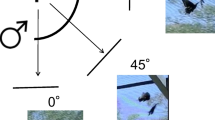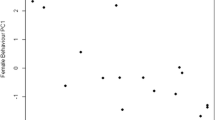Abstract
We studied two courtship displays of male peafowl (Pavo cristatus), focusing particularly on male orientation relative to the position of the sun. During the “wing-shaking” display, females were generally behind the displaying male, and male orientation with respect to the position of the sun was not significantly different from random. However, during the pre-copulatory “train-rattling” display, males were on average directed at about 45° to the right of the sun azimuth with the female positioned directly in front, suggesting that this behaviour is involved in the communication of a visual signal. A model presentation experiment confirmed that courting peacocks were more likely to perform the train-rattling display when the female was on the sunny side of their erect train, but more likely to perform wing-shaking behaviour when the female was on the shaded side of the male. This study underscores the importance of visual signalling in peafowl courtship, and we suggest that an angle of about 45° relative to the sun may allow males to enhance the appearance of their iridescent eyespot feathers.






Similar content being viewed by others
References
Able KP (1982) Skylight polarization patterns at dusk influence migratory orientation in birds. Nature 299:550–551
Anonymous (2008) Peahens do not prefer peacocks with the best tails. New Scientist 197:16
Bradbury JW, Gibson RM (1983) Leks and mate choice. In: Bateson P (ed) Mate choice. Cambridge University Press, Cambridge, UK, pp 109–133
Darwin C (1871) The descent of man, and selection in relation to sex, 1st edn. John Murray, London, UK
Endler JA, Théry M (1996) Interacting effects of lek placement, display behavior, ambient light, and color patterns in three neotropical forest-dwelling birds. American Naturalist 148:421–452
Gronbeck C (2005) SunAngle. http://susdesign.com/sunangle/. Accessed May 2008
Hamilton WJ (1965) Sun-oriented display of the Anna's hummingbird. Wilson Bulletin 77:38–44
Heindl M, Winkler H (2003) Vertical lek placement of forest-dwelling manakin species (Aves, Pipridae) is associated with vertical gradients of ambient light. Biological Journal of the Linnean Society 80:647–658
Henwood K, Fabrick A (1979) A quantitative analysis of the dawn chorus: temporal selection for communicatory optimization. American Naturalist 114:260–274
Hillgarth N (1984) Social organization of wild peafowl in India. Journal of the World Pheasant Association 9:47–56
Kannan R, James DA (1998) Common peafowl (Pavo cristatus). The Birds of North America Online. http://bna.birds.cornell.edu/bna/species/377. Accessed October 2008
Kimball RT, Braun EL, Ligon JD, Lucchini V, Randi E (2001) A molecular phylogeny of the peacock-pheasants (Galliformes: Polyplectron spp.) indicates loss and reduction of ornamental traits and display behaviours. Biological Journal of the Linnaean Society 73:187–198
Loyau A, Gomez D, Moureau B, Théry M, Hart NS, Saint Jalme M, Bennett ATD, Sorci G (2007a) Iridescent structurally based coloration of eyespots correlates with mating success in the peacock. Behavioral Ecology 18:1123–1131
Loyau A, Saint Jalme M, Sorci G (2007b) Non-defendable resources affect peafowl lek organization: a male removal experiment. Behavioral Processes 74:64–70
Loyau A, Saint Jalme M, Sorci G (2005) Intra- and intersexual selection for multiple traits in the peacock (Pavo cristatus). Ethology 111:810–820
Morell V (2008) Peacock feathers: that's so last year. ScienceNOW Daily News. http://sciencenow.sciencemag.org/cgi/content/full/2008/331/2. Accessed March 2008
National Geophysical Data Center (2008) Estimated value of magnetic declination. http://www.ngdc.noaa.gov/geomagmodels/struts/declZipE. Accessed June 2008
Nottebohm F (1971) Neural lateralization of vocal control in a passerine bird: I. Song. Journal of Experimental Zoology 177:229–262
Petrie M, Hall M, Halliday T, Budgey H, Pierpoint C (1992) Multiple mating in a lekking bird: why do peahens mate with more than one male and with the same male more than once? Behavioral Ecology and Sociobiology 31:1–10
Petrie M, Halliday T (1994) Experimental and natural changes in the peacock's (Pavo cristatus) train can affect mating success. Behavioral Ecology and Sociobiology 35:213–217
Petrie M, Halliday T, Sanders C (1991) Peahens prefer peacocks with elaborate trains. Animal Behaviour 41:323–331
Petrie M, Krupa A, Burke T (1999) Peacocks lek with relatives even in the absence of social and environmental cues. Nature 401:155–157
Snow BK (1961) Notes on the behavior of three Cotingidae. Auk 78:150–161
Takahashi M, Arita H, Hiraiwa-Hasegawa M, Hasegawa T (2008) Peahens do not prefer peacocks with more elaborate trains. Animal Behaviour 75:1209–1219
Ventolini N, Ferrero EA, Sponza S, Chiesa AD, Zucca P, Vallortigara G (2005) Laterality in the wild: preferential hemifield use during predatory and sexual behaviour in the black-winged stilt. Animal Behaviour 69:1077–1084
Walther BA (2003) Do peacocks devote maintenance time to their ornamental plumage? Time budgets of male blue peafowl Pavo cristatus. Lundiana 4:149–154
Workman L, Andrew RJ (1986) Asymmetries of eye use in birds. Animal Behaviour 34:1582–1584
Yasmin S, Yahya HSA (1996) Correlates of mating success in Indian peafowl. Auk 113:490–492
Zar JH (1999) Biostatistical analysis, 4th edn. Prentice Hall, Upper Saddle River, NJ
Acknowledgement
We thank the Assiniboine Park Zoo, Los Angeles Arboretum and Bronx Zoo for logistic support and Robert Ewart, Jason Clarke and Lori Parker for assistance in the field. Vanya Rohwer expertly prepared the model peahen, and Nick Roberts helped us understand the nature of polarized light cues. We thank Barrie Frost for his helpful suggestions. Funding was provided by a Natural Sciences and Engineering Research Council of Canada (NSERC) scholarship and the Society for Canadian Ornithologists' Fred Cooke Award to RD and by NSERC Discovery and equipment grants to RM.
Author information
Authors and Affiliations
Corresponding author
Additional information
Communicated by I. Cuthill
Electronic Supplementary Material
Below is the link to the electronic supplementary material.
Adult peacock displays. This video clip begins with a male at the Bronx Zoo (BZ, May 2008) displaying his train with no females in view then continues with a male at the Los Angeles Arboretum (LAA, March 2008) displaying to a female, first performing the wing-shaking display followed by train-rattling once the target female is in front of his erect train. The vibrating feathers can be heard during the train-rattling display.(MP4 4950 kb)
ESM 1
(DOC 50 kb)
Rights and permissions
About this article
Cite this article
Dakin, R., Montgomerie, R. Peacocks orient their courtship displays towards the sun. Behav Ecol Sociobiol 63, 825–834 (2009). https://doi.org/10.1007/s00265-009-0717-6
Received:
Revised:
Accepted:
Published:
Issue Date:
DOI: https://doi.org/10.1007/s00265-009-0717-6




